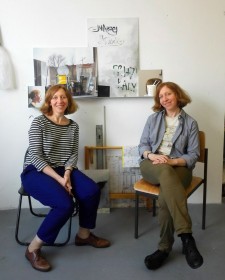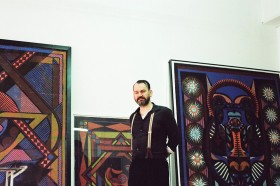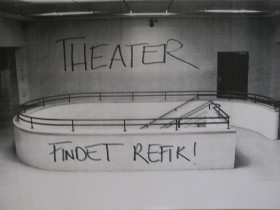A Conversation with the Artists Maria und Natalia Petschatnikov
The end of May, as the first palpable rays of sun shone in Berlin, offered the perfect occasion for an outing to Berlin’s Kreuzberg neighborhood. There the artists Maria and Natalia Petschatnikov showed me their atelier and told me about “Sparrows” and “4 Euros,” the two objects they made for the Jewish Museum Berlin’s art vending machine. They also talked about their current projects and responded with good humor to all of my questions above and beyond the subject of art.

Maria (left) and Natalia Petschatnikov in front of part of their project “Berlin & Berlin”, 2015
© and photo by Michaela Roßberg
Michaela Roßberg: You work together and you’re twins – identical twins. What is it like to work so closely? How do you develop ideas and work on projects? And does one or the other of you start with an image of the finished work in mind?
Maria: We do a lot through dialogue. It isn’t that one of us has an idea and, once a project is finished, could say: “That was my idea.” Our work emerges from a joint process. For instance, we walk through the city and see interesting things that get us thinking. We talk about them, and together, start forming ideas. → continue reading

Georg Sadowicz in his atelier
© Jewish Museum Berlin, photo: Kilian Gärtner
I’m meeting Georg Sadowicz in his atelier in Berlin-Hohenschönhausen. The Berlin-based artist was born in Liegnitz, Poland, on the German border. Since April, two of his pieces – precursors to larger work – have been made available to visitors as a limited run in the Jewish Museum Berlin’s art vending machine. They are titled, “The Cantor” and “The Mill.” Sadowicz’s atelier is a mere hundred meters from the grounds of a former Stasi detention center, now a memorial site. The sight of it troubles me, but the unease vanishes as soon as I step into Sadowicz’s atelier. → continue reading

A scene from the theater play, “Findet Refik!” © Lernkultur – Institut für Bildungsforschung und Evaluation, photo: Katharina Obens
The recently approved introduction of upper secondary level teaching at the Refik-Veseli-School was a first for Kreuzberg 36, an inner-city district of Berlin, which is very popular. Now, local kids from the neighborhood called “Wrangelkiez” need no longer travel to other districts to study for the “Abitur,” Germany’s high school diploma. This is a major step towards assuring non-segregated educational opportunities in Kreuzberg
The 8th Integrated High School in the downtown district of Kreuzberg-Berlin sealed its partnership with the Jewish Museum Berlin in June 2012. Prior to that, all the staff and pupils had voted on a new name for their school and decided to call it the Refik-Veseli-School. For during a study trip to Israel, pupils had visited the Yad Vashem Museum and learned about the history of Refik Veseli—a man acknowledged being Righteous Among the Nations.
Refik Veseli was a 17-year-old apprentice in a photo studio in Tirana, Albania, when he first met the Jewish photographer Mosche Mandil, who had fled Yugoslavia to escape the National Socialists. But in 1943 the Germans invaded Albania too, and things became much more dangerous for Jews. The Veseli family owned a house in Kruje and decided to hide Mosche Mandil and his family there. It turned out to be a three-year commitment. → continue reading


